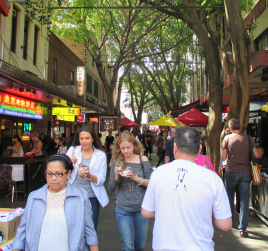Budget disappointment
28 May 2019
There was little joy for walking in the state budget, with only $15 million of new investment in walking and cycling upgrades, failing to make up for the loss of previous funds.
The budget overview claims a $45.4 million investment in “new bike and pedestrian paths across our suburbs,” but more than half of that ($27 million) will go to new bike lanes on St Kilda Rd.
There is no regular ongoing funding stream dedicated to walking for transport, so without new money, there is no money.
Excluding St Kilda Road, there is actually only $15 million of new funding for walking and cycling upgrades. Combined with existing projects, the government is planning to spend $35.5 million over two years. On an annual basis, that’s less than the $100 million over 4 years previously committed by the first Andrews Government through the Safer Cyclists and Pedestrians Fund. From a low base, funding for walking and cycling projects is declining.
“Funding for walking is going backwards, which sends a clear message to pedestrians to get back in the car,” says Victoria Walks Executive Officer Ben Rossiter.
“With 35% of people who drive to train stations living within 800 metres, the Government has failed to grasp the potential of walking investment to combat congestion.”
Besides the infrastructure funding, there is some limited operational funding to keep Active Transport Victoria as a (very small) unit of the Department of Transport, for another year at least.
There will be some walking trails provided as part of the $154 million for suburban parks, with “an additional 17-kilometre Plenty River Trail” looking like the highlight. Similarly, there is a suggestion that the $106 million to “attract visitors to Victoria’s great outdoors” will include some walking trails. The spending on regional roads will also include some minor pedestrian improvements, like upgraded pedestrian crossings at Ballarat High School.
With walking either grouped with cycling or part of broader projects, the exact investment in walking is uncertain. This confirms the need identified by Arup, looking at the economic case for walking, which called for “clear delineation of investment in walking (separate from cycling) both in budgeting and annual reporting.”
What is clear, however, is that investment in walking is miniscule when compared with spending on roads. The North East Link alone will cost $15.8 billion.
The various investments in public transport are welcome, and critical to maintain the liveability of Melbourne into the future. But there is little apparent recognition of the need for complementary walking investment.
“There is little use investing in public transport if you are not making it easy and safe for people to walk to trains and trams,” Ben Rossiter said.
In fact, the government will instead spend $150 million to make it easier to drive to train stations, with additional car parking.
One step forward, two steps back.
Read more – Victoria Walks proposals for investment in walking